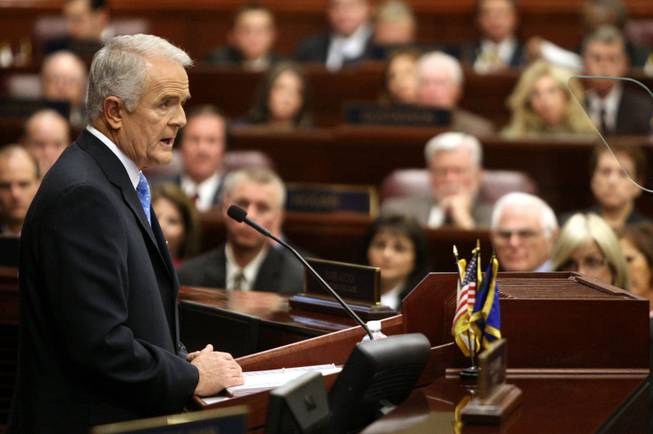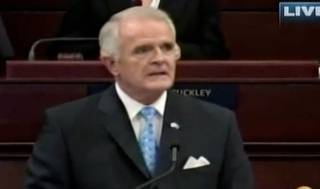
AP Photo/Nevada Appeal, Cathleen Allison
Nevada Gov. Jim Gibbons delivers his State of the State address in Carson City.
Friday, Jan. 16, 2009 | 2 a.m.
State of the State 2009

Viewing video requires the latest version of Adobe's Flash Player
STATE BUDGET CUTS
The Nevada budget shortfall for the next biennium is $2.3 billion. Gov. Jim Gibbons plans to make that up, in part, by adjusting allocations in the following areas.
38.6% — Operating reductions such as limiting hours at state parks and museums, combining agencies and closing rural mental health clinics
18.4% — Pay cut of 6 percent for state employees, including Highway Patrol troopers, DMV workers and teachers
12.3% — Increase in hotel room tax in Clark and Washoe counties. The tax hike was approved by voters in November
8.7% — Suspend merit pay increases, annual raises built into the pay scale, for state employees and teachers
6.7% — Increase in the cost of health insurance for public employees including gaming regulators and university professors
Reader poll
Related stories
- Reluctantly sharing bad news, Gibbons leaves some out
- Jon Ralston on cutting education’s nose to spite Rogers’ face
- Education, state workers hit in bare-bones budget
- Governor proposes salary cuts to avoid some layoffs
- Democratic response: Legislature will overhaul tax structure
- College students to rally against Gibbons’ budget cuts
Budget plan
Sun archives
Related blogs
There are no better punching bags for conservatives than government bureaucrats and pointy-headed professors. Thus, the budget of Gov. Jim Gibbons.
The Republican governor’s proposed $6.17 billion budget for the next two years has $2.3 billion in cuts and revenue enhancements compared with the spending plan he signed in 2007. The reductions in spending come largely on the backs of state workers, college and university employees and teachers, and in higher education.
State employees will be asked to take a 6 percent pay cut ($435 million); pay more in insurance benefit costs ($159 million); and forego scheduled merit and longevity pay increases ($213 million).
The higher education system, meanwhile, will get 36 percent less funding than was approved in 2007, a $472 million cut.
For a sense of how much bigger the hit to higher education is compared with other departments, public safety, which includes the Corrections Department, takes the next-largest hit. That agency will see a decrease of $70 million, or 11 percent less than approved in 2007.
Even if Gibbons didn’t give conservative Republicans everything they wanted in his budget — he included a room tax increase that was approved by voters — he came close. His approval rating might be dismal, but he still has his no-new-tax pledge to run on if he seeks reelection. And he took on Democratic sacred cows and fired a shot at his most consistent critic, higher education Chancellor Jim Rogers, who has repeatedly hammered the governor over his no-new-taxes stance.
With that level of cuts “we’ll have a community college system, and barely a community college system at that,” Rogers said.
At a briefing Thursday morning, Gibbons’ staff said the governor wouldn’t detail or provide a recommendation on how cuts in higher education should be carried out. His staff noted that higher education is governed by its own board, which can raise fees.
Josh Hicks, Gibbons’ chief of staff, said that as a percent of its general fund, even after the cuts, Nevada would still dedicate a larger share of its funding to higher education than the national average.
Andrew Clinger, Gibbons’ budget director, said that to save as much money as the 6 percent pay cuts will, the state would have had to lay off 9,000 to 11,000 of its 25,000 employees. That is largely because of the high cost of buying out laid-off workers.
The state would lay off 375 employees and eliminate 1,427 vacant positions under Gibbons’ spending plan.
The budget avoids some of the steepest cuts that had been discussed. When added caseload growth is factored in, Gibbons’ budget includes a 4.2 percent increase in the Health and Human Services Department. K-12 funding is reduced by only 2.6 percent, including the 6 percent salary reductions and insurance benefit changes for teachers.
Gibbons’ budget is now largely in the hands of Democrats, who control both the Assembly and Senate.
Proposed cuts in teacher and public employee pay are sure to become a lightning rod-issue as lawmakers pick apart the spending plan during committees hearings over the next two weeks leading up to the 2009 Legislature, which convenes Feb. 2.
Teachers unions, a formidable political force, will also be vocal opponents.
Senate Minority Leader Bill Raggio, R-Reno, who has sometimes stood with the governor, will likely oppose the biggest cut. Raggio has spent his entire career as a leading architect of the higher education system in Nevada. “He’s not going to spend his last term dismantling what he spent 35 years building up,” said one Republican with knowledge of the situation.
“I think the governor’s budget is irrelevant,” Rogers said. “I think the question is whether the Legislature will do something.”
With forces aligned against its no-new-taxes approach, Gibbons’ budget could be viewed as merely a hypothetical scenario.
Staff and a few outside advisers spent “hundreds of hours” putting together the spending plan.
Gibbons ordered it be done with no tax increase beyond the 3 percentage point room tax increase in Clark and Washoe counties approved by voters in November. And it includes the closure of Nevada State Prison and some conservation camps. Enrollment in Nevada Check-Up, which provides health care for children of working poor families, would be capped at 25,000, leaving 2,000 to 3,000 children on the waiting list. Eight of 20 rural mental health clinics would be closed.
The budget also makes some optimistic assumptions — that the federal government will increase Medicaid assistance by $107 million and that the room tax increase will bring in $300 million. More recent figures from the Las Vegas Convention and Visitors Authority put the room tax revenue closer to $240 million.
But in the end, the budget is balanced and there are few things the general public will scream about.
Former Gibbons campaign manager Robert Uithoven said that while some Republicans will be angry that the governor included the room tax in his budget, most will view the major test of Gibbons’ no-new-tax pledge as arriving when the Legislature sends a large tax increase for his signature in May or June.
“It’s a defensible budget to present,” Uithoven said. “The Legislature has every right to do what they want. Nobody likes to be in this situation today. But it does present an opportunity for needed reform of how government works, how it spends money, how it saves money.”

Join the Discussion:
Check this out for a full explanation of our conversion to the LiveFyre commenting system and instructions on how to sign up for an account.
Full comments policy